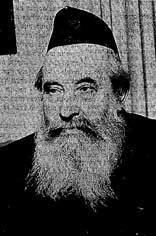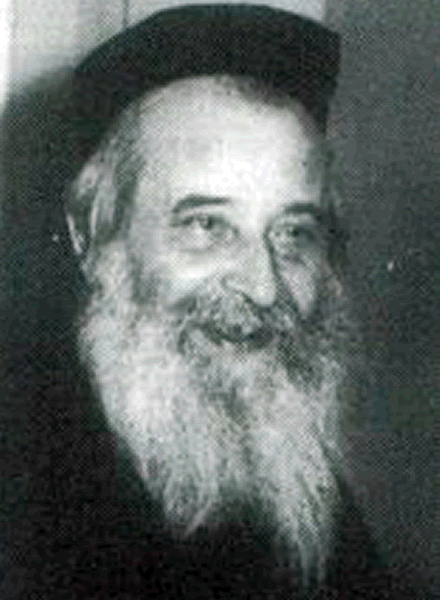Name Yechezkel Sarna | Died 1969 | |
 | ||
Rabbi Yechezkel Sarna (1890–1969) was a disciple of Rabbi Nosson Tzvi Finkel, (known as the "Alter (elder) of Slabodka"), spiritual mentor of the Slabodka yeshiva. He was sent by the Alter to move the yeshiva from Europe to Hebron in 1925, and following the Hebron Massacre of 1929, to Jerusalem. In 1934, he assumed the position of rosh yeshiva. Over the years, he produced thousands of students, many of whom became prominent roshei yeshiva and rabbis in Israel and abroad.
Contents

Early years
Sarna was born in Horodok, Russia, on the 28th Shevat in 1890. His father, Rabbi Yaakov Chaim, was the city's shochet and melamed, and later its maggid. Rabbi Sarna's mother, Aidel, was the daughter of Rabbi Shlomo Zalman Buxenbaum, a chassid of the Chiddushei Harim, and author of Rechovos Ir, a commentary on Midrash Rabba. Rabbi Sarna received his primary education from his father, as well as at the cheder in Horodok.
When he was 11, he was sent to the Ohr Hachaim yeshiva in Slabodka, headed by Rabbi Tzvi Levitan, a student of the Alter of Kelm. During the year that he studied there, he was exposed to the musar teachings of the mashgiach, Rabbi Eliyahu Laicrovits.
In 1902, he journeyed to Maltsch to study under Rabbi Zalman Sender Kahana-Shapiro, who also presided as the Chief Rabbi of the city. Due to an internal conflict in the yeshiva, Kahana-Shapiro left Maltsch, and transferred to Kriniki, barely a year after Sarna had arrived. Without a mentor, Sarna left Maltsch. A year later, he returned to Slabodka to study under Rabbi Chaim Rabinowitz in Knesses Beis Yitzchok.
In 1904, Rabinowitz invited Sarna to join a group of select students he took along with him while being transferred to the Telz Yeshiva. When the yeshiva temporarily closed in 1906, Sarna returned to Maltsch, studying under Rabbi Shimon Shkop. One year later, he returned to Knesses Yisroel Yeshiva in Slabodka, where he became one of the yeshiva's best students. He drew attention of the Alter, who played a major role in his spiritual growth. Describing their special relationship, Sarna wrote, "Without the Alter, I would have been like a blind and a deaf person. He opened my eyes and my ears, and I acquired my entire approach to Torah study from him."
World War I
With the outbreak of World War I, the entire Slabodka yeshiva fled to Minsk. Like all of the yeshiva's students, Sarna secured forged affidavits in order to avoid the draft. However, he was caught and imprisoned. He managed to escape from prison and flee to the home of a relative, Rabbi Yehoshua Zimbalist. Soon after, he escaped to Smilowitz where the Chofetz Chaim and his students had taken refuge.
Shortly after the Slabodka yeshiva had arrived in Minsk, which was near the battlefront, it was forced to flee to a safer city, Kremenchuk. However, Sarna chose not to join the yeshiva, but remained in Smilowitz, studying for a year and a half in an inn with the students of the Raduń Yeshiva. During this period, he developed close relationships with the Chofetz Chaim and Raduń's rosh yeshiva, Rabbi Naftoli Trop, and later referenced this brief period as one of the most beautiful in his life.
After the revolution, Rabbi Sarna returned to the Knesses Yisroel yeshiva in Kremenchuk. Two years later, he married Pesha Miriam Epstein, the daughter of Rabbi Moshe Mordechai Epstein, one of the yeshiva heads.
Shortly after World War I, the yeshiva managed to leave Russia and to return to Slabodka, which, after the war, was re-annexed to Lithuania. At one point, the Alter asked Rabbi Sarna to deliver shiurim (lectures) in the yeshiva, but he declined the offer, explaining that he preferred to devote the early years of his life to Torah study. Although Rabbi Sarna held no official position in the yeshiva, his influence there was keenly felt.
Palestine
In 1924, following the edict requiring enlistment in the military or supplementary secular studies in the yeshiva, the decision was made to transfer the yeshiva to Eretz Yisroel. Sarna was sent to Eretz Yisroel to choose a site for the yeshiva and to coordinate its establishment there. After evaluating various options he chose the city of Hebron. Consequently, Knesses Yisroel became the first Lithuanian yeshiva to transfer to Eretz Yisroel. At that period, Sarna assumed a significant role in the yeshiva's leadership, delivering shiurim (lectures) and coordinating study schedules. In the beginning of 1927, the Alter fell seriously ill, and Sarna began to deliver musar discourses in the yeshiva.
In the course of the 1929 Palestine riots, 24 of the yeshiva's students had been killed and many were injured. Sarna succeeded in reestablishing the yeshiva in Jerusalem. He renamed it "Hebron", in memory of those who were massacred in that city. While Rabbi Leib Chasman, the yeshiva's mashgiach, dedicated himself to encouraging the students, Sarna took the task of fund raising for the yeshiva, traveling extensively, even making several trips to the United States.
In a letter to Rabbi Isaac Sher of Slabodka, he wrote, "The first weeks were very difficult, since the students were both destitute and despondent. But by the 15th of Elul, they returned to themselves, and by Rosh Hashana, the yeshiva began to function in full force."
When his father-in-law, Rabbi Moshe Mordechai, died in 1933, four years after the Hebron Massacre, Rav Yechezkel was officially appointed rosh yeshiva of Hebron.
Community involvement and leadership
With the start of World War II and the Holocaust, Sarna expanded the scope of his activities: he was among the founders of the Vaad Yeshivos, and was also active in the Vaad Hatzalah. After the founding of the State of Israel, Sarna served as one of the leaders of the Chinuch Atzmai Torah School Network. Although he shunned direct political involvement, Rabbi Sarna had a strong affinity for Agudas Yisroel, and he was an active member of its Council of Torah Sages.
Despite the involvement in community and Jewish projects, the Hebron yeshiva and its students remained his lifework. He delivered shiurim in halacha and musar every week at the yeshiva and in his own home. For seven years, he also delivered discourses on the laws and meaning of Shabbat. In 1936, with the passing of the yeshiva's mashgiach, Rabbi Yehuda Leib Chasman, Sarna assumed that role himself.
As rosh yeshiva and mashgiach, he acted warmly toward his students. This attitude is apparent in one of his letters, in which he wrote, "Yesterday, I entered the yeshiva close to midnight, and found thirty students studying with exceptional fervor. At that time, I thought, 'Fortunate is the generation which has merited such young people. May Hashem protect them and bless them.'"
Over time, his brothers-in-law, Rabbis Aaron Cohen and Moshe Chevroni, were appointed roshei yeshiva of Hebron, while Rabbi Meir Chadash was appointed mashgiach. Later, Rabbis Hillel Paley, Simcha Zissel Broide and Avrohom Farbstein were also invited to become roshei yeshiva there.
Final days
In his last months, Sarna kept davening at the yeshiva and delivering shiurim. In 1969, he was taken to Hadassah Ein Kerem Hospital for intensive treatment. Two days before his death, he was reported to have said, "It is Elul and the students are surely studying with added hasmada. My illness won't disturb their Elul mood." He died on 6 Elul and was buried beside his father-in-law, R. Moshe Mordechai Epstein, on the Mount of Olives.
